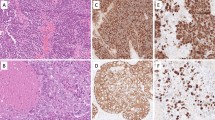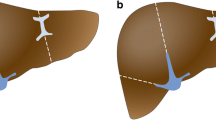Abstract
Objectives
We retrospectively evaluated the doubling time (DT) of thymic epithelial tumours (TET) according to the histological subtype on CT.
Methods
From January 2005 to June 2016, we enrolled 53 patients who had pathologically confirmed TET and at least two CT scans. Tumour size was measured using a two-dimensional method, and the DT was calculated. DTs were compared among histological subtypes, and factors associated with rapid tumour growth (DT <180 days) were assessed.
Results
In 42 of the 53 patients (79.2%) the tumours showed interval growth (>2 mm) during follow-up. The median DT for all tumours was 400 days (range 48–1,964 days). There were no significant differences in DT in relation to histological subtype (p = 0.177). When TETs were recategorized into three groups, i.e. low-risk thymomas (types A, AB, B1), high-risk thymomas (types B2, B3), and thymic carcinoma, DT was significantly different among the groups (median DT 436, 381 and 189 days, respectively; p = 0.031). Histological subtype (type B3 and thymic carcinoma) was the single independent predictor of rapid tumour growth.
Conclusions
The majority of TETs grew during follow-up with variable and relatively slow growth rates. Histological features of aggressive behaviour significantly correlated with a decreased DT and rapid growth.
Key points
• The majority of thymic epithelial tumours grew during follow-up (79.2%, 42/53).
• Doubling times of thymic epithelial tumours were highly variable (median 400 days).
• Histological features of aggressive behaviour significantly correlated with a decreased doubling time.



Similar content being viewed by others
Abbreviations
- CT:
-
Computed tomography
- DT:
-
Doubling time
- IQR:
-
Interquartile range
- TET:
-
Thymic epithelial tumour
- WHO:
-
World Health Organization
References
de Jong WK, Blaauwgeers JL, Schaapveld M, Timens W, Klinkenberg TJ, Groen HJ (2008) Thymic epithelial tumours: a population-based study of the incidence, diagnostic procedures and therapy. Eur J Cancer 44:123–130
Engels EA (2010) Epidemiology of thymoma and associated malignancies. J Thorac Oncol 5:S260–S265
Nishino M, Ashiku SK, Kocher ON, Thurer RL, Boiselle PM, Hatabu H (2006) The thymus: a comprehensive review. Radiographics 26:335–348
Wright CD (2008) Management of thymomas. Crit Rev Oncol Hematol 65:109–120
Priola AM, Priola SM, Giaj-Levra M et al (2013) Clinical implications and added costs of incidental findings in an early detection study of lung cancer by using low-dose spiral computed tomography. Clin Lung Cancer 14:139–148
Henschke CI, Lee IJ, Wu N et al (2006) CT screening for lung cancer: prevalence and incidence of mediastinal masses. Radiology 239:586–590
Tomiyama N, Honda O, Tsubamoto M et al (2009) Anterior mediastinal tumors: diagnostic accuracy of CT and MRI. Eur J Radiol 69:280–288
Araki T, Sholl LM, Gerbaudo VH, Hatabu H, Nishino M (2014) Intrathymic cyst: clinical and radiological features in surgically resected cases. Clin Radiol 69:732–738
McErlean A, Huang J, Zabor EC, Moskowitz CS, Ginsberg MS (2013) Distinguishing benign thymic lesions from early-stage thymic malignancies on computed tomography. J Thorac Oncol 8:967–973
Shin KE, Yi CA, Kim TS et al (2014) Diffusion-weighted MRI for distinguishing non-neoplastic cysts from solid masses in the mediastinum: problem-solving in mediastinal masses of indeterminate internal characteristics on CT. Eur Radiol 24:677–684
van Klaveren RJ, Oudkerk M, Prokop M et al (2009) Management of lung nodules detected by volume CT scanning. N Engl J Med 361:2221–2229
Weis CA, Yao X, Deng Y et al (2015) The impact of thymoma histotype on prognosis in a worldwide database. J Thorac Oncol 10:367–372
Falkson CB, Bezjak A, Darling G et al (2009) The management of thymoma: a systematic review and practice guideline. J Thorac Oncol 4:911–919
Jeong YJ, Lee KS, Kim J, Shim YM, Han J, Kwon OJ (2004) Does CT of thymic epithelial tumors enable us to differentiate histologic subtypes and predict prognosis? AJR Am J Roentgenol 183:283–289
Lindell RM, Hartman TE, Swensen SJ et al (2007) Five-year lung cancer screening experience: CT appearance, growth rate, location, and histologic features of 61 lung cancers. Radiology 242:555–562
Schwartz M (1961) A biomathematical approach to clinical tumor growth. Cancer 14:1272–1294
Usuda K, Saito Y, Sagawa M et al (1994) Tumor doubling time and prognostic assessment of patients with primary lung cancer. Cancer 74:2239–2244
Marx A, Strobel P, Badve SS et al (2014) ITMIG consensus statement on the use of the WHO histological classification of thymoma and thymic carcinoma: refined definitions, histological criteria, and reporting. J Thorac Oncol 9:596–611
Travis WD, Brambilla E, Müller-Hermelink HK et al (2004) Pathology and genetics of tumours of the lung, pleura, thymus and heart. IARC Press, Lyon
Hoaglin DC, Iglewicz B, Tukey JW (1986) Performance of some resistant rules for outlier labeling. J Am Stat Assoc 81:991–999
Detterbeck FC (2006) Clinical value of the WHO classification system of thymoma. Ann Thorac Surg 81:2328–2334
Suster S, Moran CA (2005) Problem areas and inconsistencies in the WHO classification of thymoma. Semin Diagn Pathol 22:188–197
Verghese ET, Den Bakker MA, Campbell A et al (2008) Interobserver variation in the classification of thymic tumours – a multicentre study using the WHO classification system. Histopathology 53:218–223
Travis WD, Brambilla E, Burke AP et al (2015) WHO classification of tumours of the lung, pleura, thymus and heart. IARC Press, Lyon
Marx A, Chan JK, Coindre JM et al (2015) The 2015 World Health Organization classification of tumors of the thymus: continuity and changes. J Thorac Oncol 10:1383–1395
Henschke CI, Yankelevitz DF, Yip R et al (2012) Lung cancers diagnosed at annual CT screening: volume doubling times. Radiology 263:578–583
Detterbeck FC, Gibson CJ (2008) Turning gray: the natural history of lung cancer over time. J Thorac Oncol 3:781–792
Marom EM (2013) Advances in thymoma imaging. J Thorac Imaging 28:69–80, quiz 81–63
Benveniste MF, Rosado-de-Christenson ML, Sabloff BS et al (2011) Role of imaging in the diagnosis, staging, and treatment of thymoma. Radiographics 31:1847–1861, discussion 1861–1843
Marom EM (2010) Imaging thymoma. J Thorac Oncol 5:S296–S303
Hayes SA, Huang J, Plodkowski AJ et al (2014) Preoperative computed tomography findings predict surgical resectability of thymoma. J Thorac Oncol 9:1023–1030
Author information
Authors and Affiliations
Corresponding author
Ethics declarations
Guarantor
The scientific guarantor of this publication is Dr. Sang Min Lee.
Conflict of interest
The authors of this manuscript declare no relationships with any companies, whose products or services may be related to the subject matter of the article.
Funding
The authors state that this work did not receive any funding.
Statistics and biometry
No complex statistical methods were necessary for this paper.
Ethical approval
Institutional Review Board approval was obtained.
Informed consent
Written informed consent was waived by the Institutional Review Board.
Methodology:
• Retrospective
• Observational
• Performed at one institution
Rights and permissions
About this article
Cite this article
Choe, J., Lee, S.M., Lim, S. et al. Doubling time of thymic epithelial tumours on CT: correlation with histological subtype. Eur Radiol 27, 4030–4036 (2017). https://doi.org/10.1007/s00330-017-4795-y
Received:
Revised:
Accepted:
Published:
Issue Date:
DOI: https://doi.org/10.1007/s00330-017-4795-y




